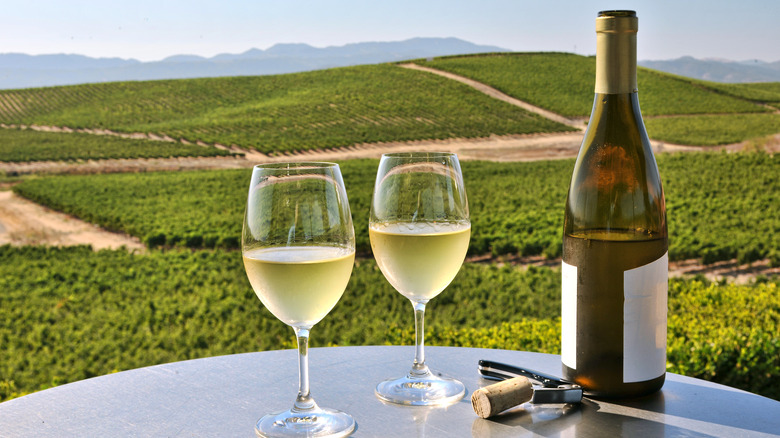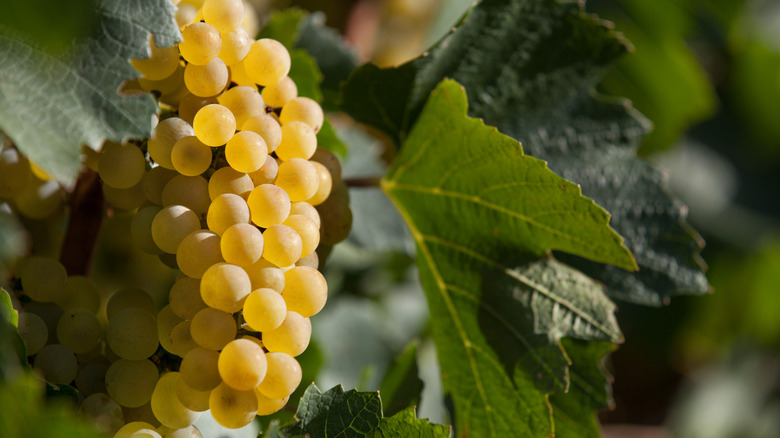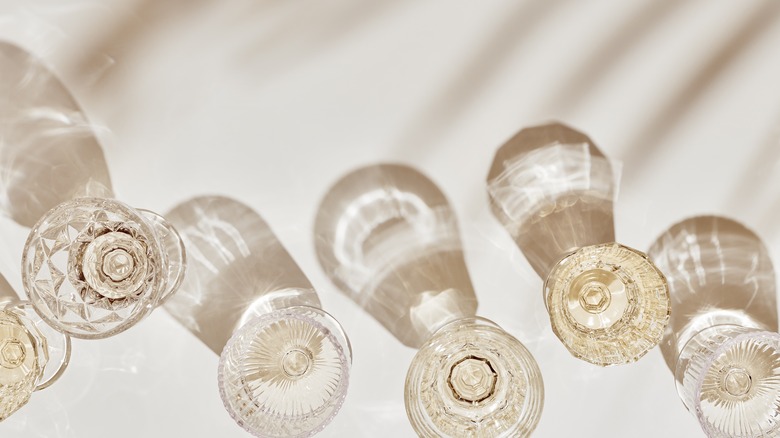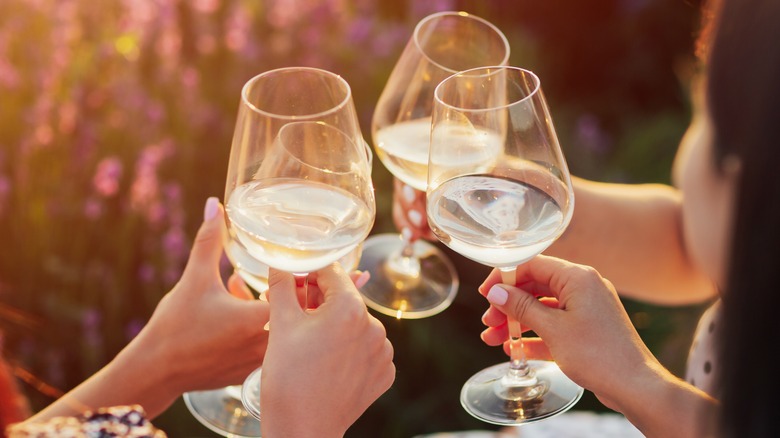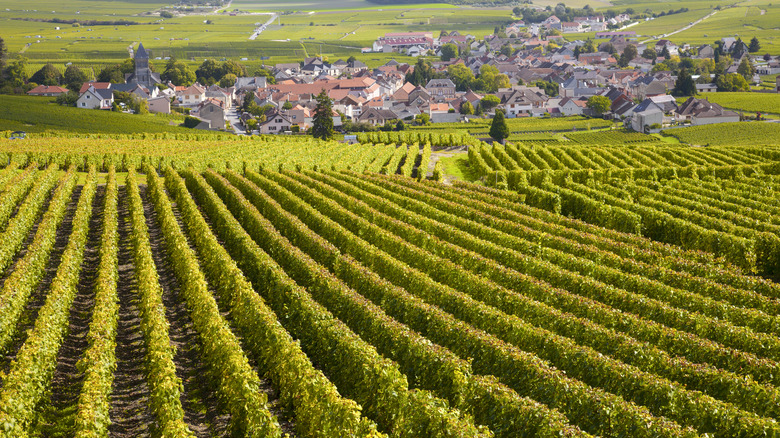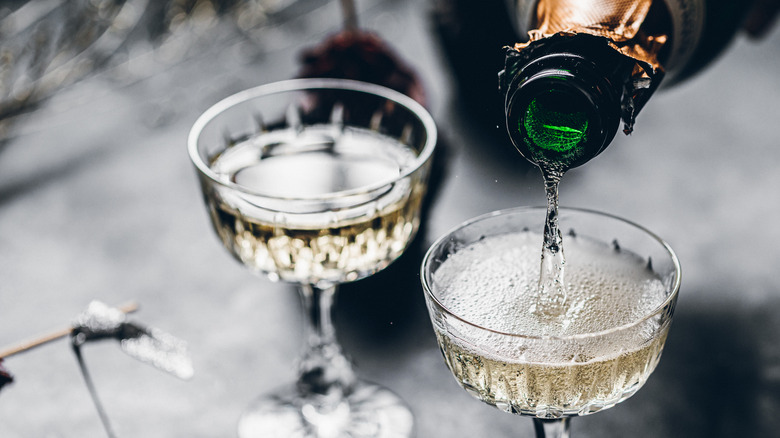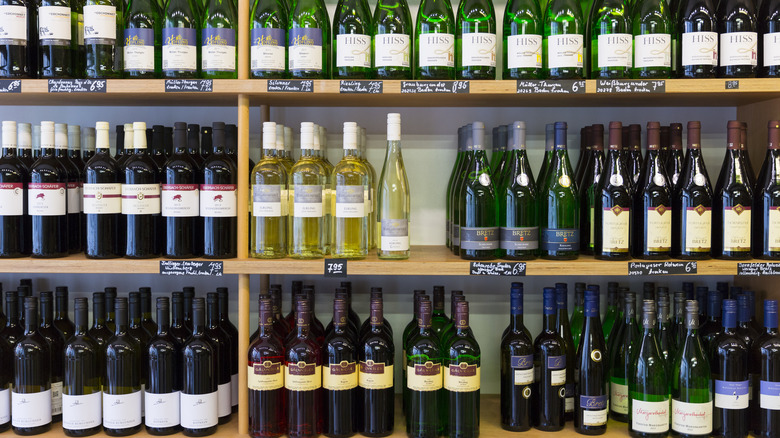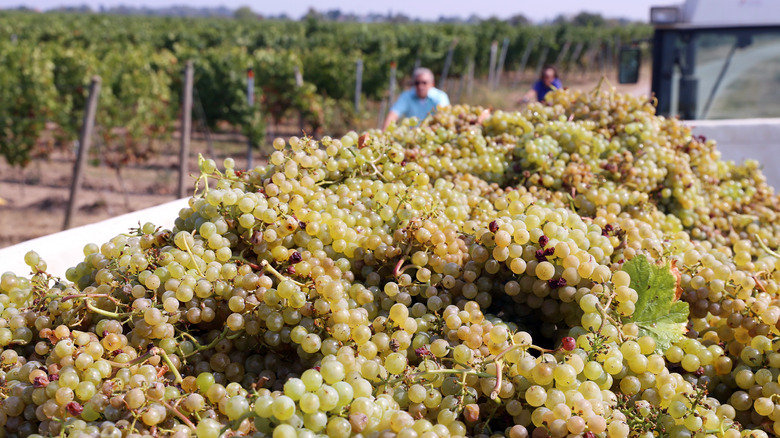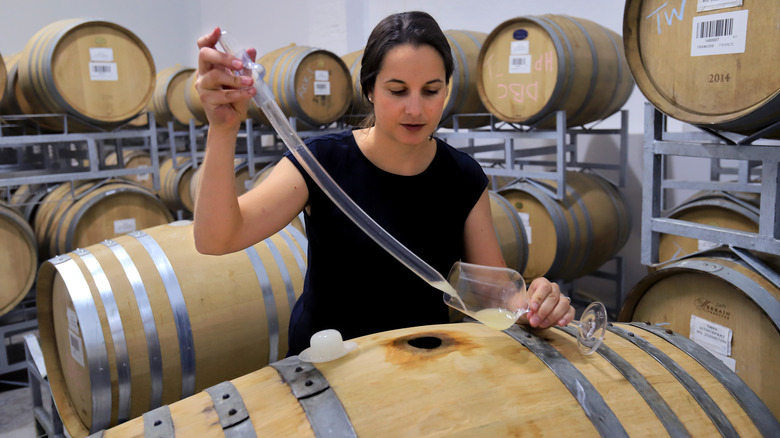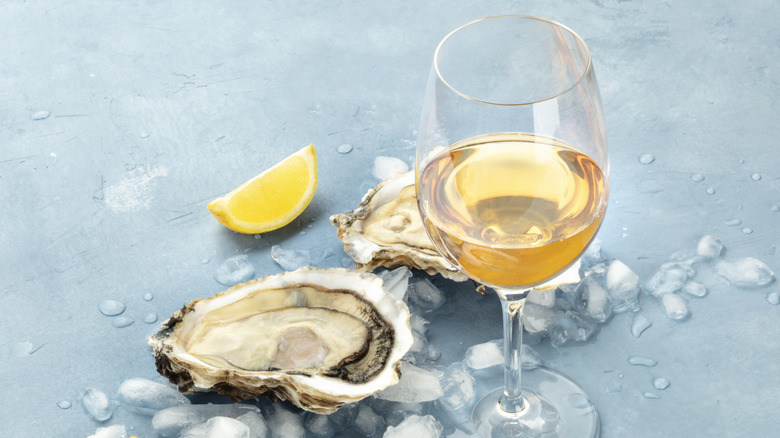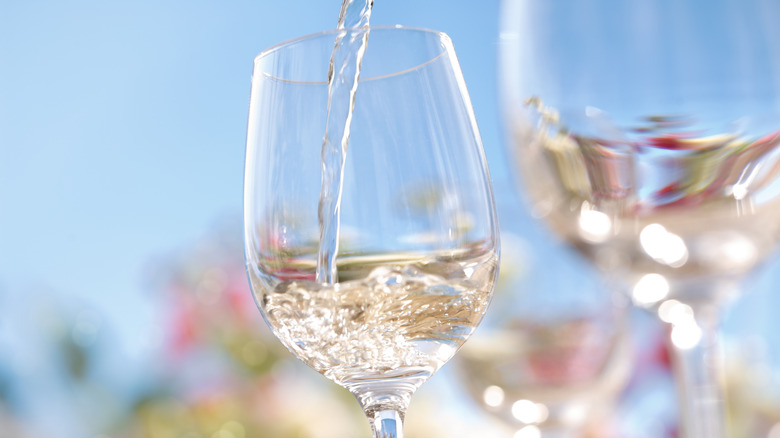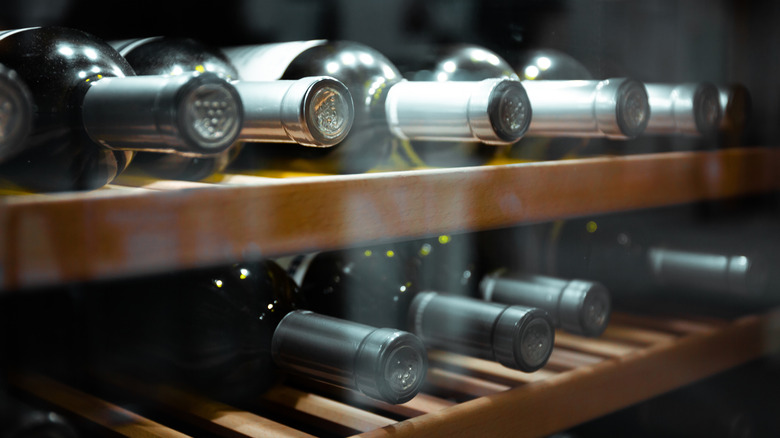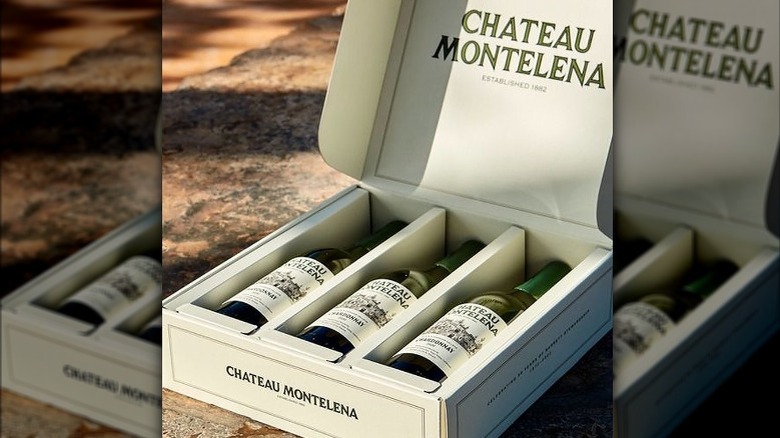A Guide To Chardonnay: Everything To Know About The White Wine
Whether you enjoy the occasional glass of wine or can recite all the first-growth châteaux in Bordeaux, you're probably familiar with chardonnay. It comes only second to airén in terms of white grape vineyard acreage. Part of chardonnay's consumer appeal is its ubiquity; it grows in over 40 countries, meaning you're never too far from a bottle of the stuff.
It has had its share of critics over the years, including the ABC club (anything but chardonnay), with its firm stance against overly oaked, rich, and buttery versions of the white wine. Meanwhile, select winemakers designated their approach as being "in pursuit of balance" (IPOB), avoiding the use of new oak barrels, certain types of fermentation, and high alcohol contents.
While dogmatic attitudes toward the grape have died down in the last few years, many people have yet to discover the vast world of chardonnay. Commonly labeled as a chameleon grape,t the green-skinned variety encompasses a wide range of styles. Whether you're in the mood for ripe tropical fruit aromas, crisp citrus notes, or Champagne (yes, the real deal), chardonnay can satisfy your needs.
What is chardonnay?
As one of the most recognizable wines in the world, chardonnay has a reputation that precedes it wherever it goes. Vineyards worldwide grow it, and you would be hard-pressed to find a wine shop that doesn't carry it. The green-skinned grape comes from one of its most prized growing regions: Burgundy, France, where you'll find the small town of Chardonnay. Home to some of the most prestigious chardonnay bottles in the world, it makes sense that it's the same place that birthed the grape. Regional wine regulations require local white Burgundy to be made with chardonnay.
It's funny to think of plants as having parents, but most grapes can be traced to a cross between others. In the case of chardonnay, DNA studies conducted at UC Davis indicate that pinot noir and gouais blanc are its source.
As a highly adaptable grape, chardonnay grows in a vast range of soil types and climates, providing a spectrum of styles for all consumers. Furthermore, its fairly neutral characteristics make it an excellent candidate for oak aging and other practices in the cellar. Ultimately, there is a great deal of variation as to what you can expect from chardonnay, and understanding some of the factors that affect its taste will help you purchase a bottle.
Styles of chardonnay
There are many ways to categorize chardonnay, from the vineyard to the cellar. Location dictates a great deal about the final product. As with any fruit, grapes that receive plenty of sunlight and heat will ripen more fully. On the flip side, fruit in cool climates will retain more acidity and tart aromas. Cool climate and warm climate wines are distinguished on these bases, and the resulting beverage can be quite distinct. For chardonnay, the former brings out a lean refreshing style with notable crispness and hints of green apple and lemon. The latter is fuller-bodied with ripe tropical fruit aromas on the palate.
In the cellar, chardonnay often undergoes oak barrel aging, which imparts a whole set of qualities to the fermented juice. Depending on the type of oak, you might get notes of brioche, vanilla, butterscotch, caramel, coconut, or spices. These styles have a fuller body and can stand up to heartier foods. When the juice is fermented in stainless steel tanks or other neutral vessels, the fruit flavor is prominent with nothing masking its true aromas.
Another way to classify chardonnay is as a sparkling or still wine. If you're a Champagne drinker, you might be surprised that almost a third of the vineyards are planted with chardonnay grapes (via Comité Champagne). Crémant and Franciacorta, other styles of sparkling wine, are commonly made with chardonnay too.
How much alcohol is in chardonnay?
A wine's alcohol content has various influences, starting with the ripeness of the fruit at the time of harvest. Alcohol is created when sugar and yeast ferment, and in the case of wine, the sugar comes from grapes. As anyone who's ever tasted underripe fruit knows, the contrast can be stark. Grapes ripen more quickly in warm-climate wine-growing regions, which can boost the sugar and consequently the alcohol by volume (ABV) into the high teens. On the other hand, cool climates where grapes struggle to ripen tend to display lower ABVs.
Depending on the style, white wines can range from 5% to 14.5% ABV. On the lower end of the spectrum, the wines will typically be sweet due to the presence of unfermented sugar. As the numbers creep up, you'll find many wines made with ripe grapes from warm climates.
The amount of alcohol in your bottle of chardonnay varies depending on its source, but it sits in the mid to high range. Bottles from Burgundy, which has a continental climate, are slightly lower, sitting between 11.5% to 13.5% (via Wine Folly). If you head to warmer regions like California, Australia, and Chile, you're looking at an ABV that easily reaches 14.5%. If California chardonnay hits you harder than a white Burgundy, you're not imagining it.
What does chardonnay taste like?
Part of chardonnay's widespread appeal is the fact that it can produce wines with such varied flavor profiles. From vibrant Blanc de Blancs Champagnes to buttery oak-aged wines, not to mention the mineral wonders of Chablis and the refreshing bottles from coastal Chile, chardonnay is a force to be reckoned with. The grapes have a relatively neutral taste, with aromas of lemon, apple, pear, and pineapple among the fruit. Lighter styles amp up the citrus and acidity, while rounder fuller-bodied ones express butter, vanilla, almond, and honeysuckle. Somewhere in the middle, expect a fruity wine with a tame acidity and a bold tropical profile.
Climate has a significant influence on the result, and many regional styles of chardonnay are recognizable with little training. Cooler regions veer on the lighter spectrum, whereas warmer areas offer a fuller mouthfeel. As well, winemaking practices have a notable impact on the flavors. New oak barrels impart aromas, including vanilla, brioche, butterscotch, and coconut. Or, winemakers can choose to ferment chardonnay in neutral oak, stainless steel tanks, or concrete vessels, allowing the fruit to express itself fully. Letting malolactic fermentation take place creates a rounder softer wine with hints of butter. Meanwhile, occasionally stirring the dead yeast cells in the wine as it matures amplifies textural characteristics. It's no wonder chardonnay is such an internationally popular variety.
Prime chardonnay growing regions
It's grown in around 40 countries worldwide, but not all regions make chardonnay worth revering. Starting at the source, Burgundy in France is the homeland of the famous grape. Here, it thrives in the Côte de Beaune and Mâconnais, and in the northerly Chablis, set firmly apart with its ultra-lean style. Champagne, of course, grows plenty of the stuff for its prized sparkling wines, as does the northern-Italian region of Franciacorta. Among the top players, California is a no-brainer. The state may be best known for its full-bodied oak-aged styles, but that's only part of the story. Coastal regions produce lighter crisp wines, and rich heavy styles are becoming more tame.
Australia is taking the lead with the variety too, producing excellent versions from vineyards in Margaret River, in the southwest of the country. Pick up a bottle from New Zealand, Chile, or Argentina if you're in the mood for higher acid mineral styles or tropical fruit-forward options — it's all available.
Chardonnay in Champagne
If you regularly shun chardonnay but happily sip on Champagne, it's worth noting that a large proportion of bubby is actually made with the same grape. Chardonnay plantings cover 31% of the region's vineyards, particularly in the Côte des Blancs area. Non-vintage Champagne made by producers on a yearly basis contains around a third of chardonnay in the blend.
Meanwhile, if the label states "Blanc de Blancs," chances are it's 100% chardonnay. Although other Champagne grapes — pinot gris, pinot blanc, arbane, and petit meslier — are permitted in these all-white blends, they only make up 0.3% of the total vineyard area.
While the other two main Champagne grapes — pinot noir and pinot meunier — infuse the sparkling beverage with elegant and sophisticated aromas, chardonnay brings a bright and floral quality to the wine. Citrus and green apple notes add a crisp element, along with the chalky minerality that is a cornerstone of the popular drink. Blanc de Blancs Champagne ages well thanks to its high acidity, and some experts recommend waiting a minimum of 10 to 15 years before even considering popping the cork (via Wine Enthusiast).
Chardonnay vs other popular varieties
Considering chardonnay's diverse styles, it has something in common with many white varieties. Pinot grigio is another popular grape found worldwide, which tends to have higher acidity and more citrus elements than chardonnay. It is not typically oak-aged, which keeps the profile lighter on the palate.
Meanwhile, comparing sauvignon blanc with chardonnay yields notable distinctions. The former is typically heavy in herbal aromas and notes of passionfruit and gooseberry, whereas chardonnay sticks to subtler fruits like apple and lemon. Additionally, sauvignon blanc tends to have a higher acidity which makes it a great pairing with light seafood dishes. Thanks to its recognizable aromas, it is less influenced by winemaking practices and not commonly aged in oak.
As for pinot blanc, it shares similar origins with chardonnay and is also one of the grapes allowed in Champagne blends. If offers notes of almonds and apples, with relative acidity and a medium-full body. While it doesn't undergo oak aging in all bottlings, some styles follow this approach.
Grapes chardonnay lovers would also like
If you love chardonnay but are curious to step outside of the familiar, there are many paths to take. If you're after lush tropical flavors, stone fruit, lower acidity, and a rounder mouthfeel, pick up a bottle of viognier. The French variety is full-bodied and commonly aged in oak to enhance its creamy characteristics. Floral notes are layered with fruit, making viognier a richly aromatic wine.
Usually blended together (often with viognier too), roussanne and marsanne grow in France's Rhône Valley, producing smooth aromatic whites with nuanced flavors. With honeyed notes and a floral element, these wines take on a softer style that might appeal to warm-climate chardonnay fans.
For something with a bit more zing yet carrying a similar green apple, lemon, and stonefruit profile, chenin blanc is an excellent option. The variety grows in France's Loire Valley and in large quantities in South Africa, where it is a local favorite. There are high-acid styles with notes of ginger, honeysuckle, and quince to round it out. On the other end, warmer climates result in more luscious fruit aromas. Chenin is also used to make excellent dessert and sparkling wines, showcasing some of the same chameleon-like tendencies as chardonnay.
How is chardonnay made?
As with all white wine production, chardonnay grapes are picked from the vines either manually or by machine, then transported to the winery. Here, the fruit is pressed and separated from the skins to maintain a clear hue. The juice typically sits for some time to allow sediments to fall to the bottom of the tank before fermentation begins. This can occur spontaneously with the presence of wild yeasts on the fruit and in the cellar. For more consistent results, winemakers often inoculate the juice with manufactured yeast to initiate fermentation. Either way, the alcohol-making step occurs over approximately two weeks, although wild yeasts may take longer.
The next steps vary depending on the style of chardonnay desired. Most notably, choosing whether to make oaked or unoaked chardonnay has a major impact on the final result. Neutral oak barrels have been used repeatedly and don't impart much aroma, however, new oak certainly does. Notes of brioche, vanilla, coconut, and almond might be present, which stands apart from the crisper fruit-forward outcome of aging chardonnay in stainless steel or concrete vessels.
In the case of oaked chardonnay, malolactic fermentation, and bâtonnage typically follow in the production. Otherwise, the wine is usually filtered and clarified to get rid of any sediments, particles, and cloudiness before being bottled.
The influence of malolactic fermentation and bâtonnage
Fuller-bodied chardonnays are often the result of time spent maturing in oak barrels. However, one of the key characteristics of the flavor profile is misattributed to oak. Buttery aromas are present due to a secondary process called malolactic fermentation, which occurs due to the presence of bacteria. In technical terms, it transforms malic acid into lactic acid; tastewise, the wine shifts from being tart and crisp to soft and creamy. Various compounds are responsible for the wine's transformation, including diacetyl, which is present in butter, hence the resulting aroma.
Bâtonnage is another technique to alter the style of chardonnay by stirring dead yeast cells (lees) as they settle to the bottom of a barrel. While that might sound like the last thing you want whisking throughout your wine, lees lend a creamy texture that can do wonders to enhance the mouthfeel. Finding the ideal harmony between adding richness and maintaining balance is essential.
What to pair with chardonnay
Considering the many styles of chardonnay, you could make a case for serving it with anything. Starting with perhaps the most unlikely pairing, serving steak with chardonnay is popular among sommeliers and steakhouse aficionados. Fuller-bodied barrel-aged wines display luscious aromas that stand up to the hearty meat. Fans of the pairing point to dry-aged steak as an optimal choice, which develops nutty and buttery notes over time that complement the features of oak-aged chardonnay.
As for more intuitive pairings, lighter unoaked cool-climate chardonnay is a stellar match with seafood, both raw and delicately cooked. Chablis or Champagne with oysters is a natural duo, as the citrusy notes and high acidity elevate the bivalves like a squeeze of lemon juice; the two make an excellent accompaniment for sushi or sashimi too.
Warmer climate versions can handle dishes with a bit more weight, such as creamy seafood or poultry pasta, salmon, ham, or even a mild curry. As the wine deepens in complexity, it can take on a food pairing with more elements of flavor, such as grilled seafood, cheddar cheese, mushroom dishes, and veal.
How to serve chardonnay
Wine drinkers tend to serve white bottles too cold and red ones too warm. Lighter-bodied white wines should be served between 40 and 50 degrees Fahrenheit, while fuller-bodied bottles can be served from 48 to 60 degrees. Chill your wine too much and all of the nuanced aromas will be muted. Test it out for yourself by comparing freshly poured wine with what's been sitting in your glass for 20 minutes.
Since chardonnay comes in many versions, a temperature around 48 to 50 degrees Fahrenheit should be suitable. You'll want to serve Champagne at a similar coolness to fully savor its rich aromas. The amount of time needed to chill your wine will vary based on how it is stored, but BinWise notes that it will decrease by 1 degree per 3 minutes in a freezer or ice bucket. Or, simply pop it in the fridge about 2 hours before you plan to serve it.
Unless you're serving an old bottle with sediment, chardonnay doesn't benefit much from being decanted. As for glasses, a universal wine glass is a versatile option, or if you have plenty of shelf space you could even buy a vessel specifically designed for chardonnay. Assess the style of chardonnay before pouring; if it's light and crisp, stick to a narrower glass to retain the subtle aromas. Meanwhile, if it's a fuller and richer style, a glass with a wider opening will allow the wine to express its full potential.
How long does chardonnay last?
Most wine on the market is made to be consumed within a few years. If you're planning to keep it longer, you'll want to have temperature-stable storage to reduce the risk of damage. Optimal cellar conditions are 55 to 60 degrees Fahrenheit, so invest in a wine fridge for prolonged storage. Heat, light, and vibrations can all negatively affect chardonnay, and if your bottle has a cork, you should lay it on its side to ensure it does not dry out over time.
Higher-acid styles, like Chablis or Champagne, as well as those with oak aging, fare well over time and can last for 10 years if not more. Nevertheless, just because a wine has the capacity to age doesn't mean you'll like it. As wine matures it develops tertiary aromas, which in the case of chardonnay can include nutty flavors with hints of vanilla, brioche, and spices. If you like your wine with fresh fruit on the palate, drink it sooner rather than later.
Meanwhile, if you opened a bottle over the weekend and didn't get through it, seal it and store it in the fridge. Contact with oxygen will initiate its decline, so try to finish it within three to five days to enjoy it at its prime. Transferring it to a smaller bottle or using a device that pumps out air are a few ways to extend the freshness, but you'll definitely want to drink it within the week.
Most coveted chardonnays
Some of the priciest white wines in the world are made with chardonnay — namely bottles from Burgundy and Napa Valley. In 1976, the two regions came face to face in the Judgment of Paris, a competition that altered the course of American wine. Previously, old-world wine countries with centuries of tradition were considered the only source of fine wine. At the event, wine experts blind-tasted several wines, choosing a bottle of 1973 Chateau Montelena from Napa as the winner against a chardonnay from Burgundy. This moment paved the way for chardonnay in California.
Back in Burgundy, the top chardonnays come from vineyards in the Côte de Beaune, as well as in Chablis, which is situated further north. Regions like Montrachet and Meursault are known for their opulent wines. Yet more north, Champagne is perhaps one of the most well-known prestigious chardonnays around.
